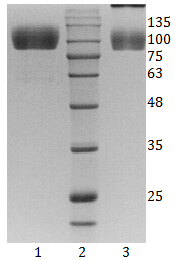Otsi
Otsi

Figure 1. SDS-PAGE analysis of human RET635 visualized by PageBlue protein staining solution (Fermentas). Lane 1. 2 µg of human RET635 (reduced); Lane 2. Protein size marker ( Prestained protein ladder, 8003, Naxo); Lane 3. 2 µg of human RET635 (non-reduced).
Catalogue #
P-124-100
Name
RET-His, human recombinant
Synonyms
Cadherin family member 12, Proto-oncogene c-Ret
Description
Protein contains only extracellular domain of the RET (aa 29-635)
Uniprot ID
P07949
Source
Human
MW
Approximately 68.6 kDa, a single non-glycosylated polypeptide chain containing 613 amino acids including C-terminal hexahistidine tag
Host
CHO-based cell line (expressed by QMCF Technology)
Purification
Purified by Ni-affinity chromatography and gel-filtration from serum-free CHO growth media
Concentration
0.23 mg/ml
Buffer
PBS pH 7.4
Endotoxine
Not tested
QC
Coomassie-stained SDS-PAGE
Shipping
Shipped on dry ice
Storage
Store at -70°C upon receipt. Recommended to aliquot into smaller quantities. Avoid repeated freeze-thaw cycles
Background
Receptor tyrosine-protein kinase involved in numerous cellular mechanisms including cell proliferation, neuronal navigation, cell migration, and cell differentiation upon binding with glial cell derived neurotrophic factor family ligands. Phosphorylates PTK2/FAK1. Regulates both cell death/survival balance and positional information. Required for the molecular mechanisms orchestration during intestine organogenesis; involved in the development of enteric nervous system and renal organogenesis during embryonic life, and promotes the formation of Peyer's patch-like structures, a major component of the gut-associated lymphoid tissue. Modulates cell adhesion via its cleavage by caspase in sympathetic neurons and mediates cell migration in an integrin (e.g. ITGB1 and ITGB3)-dependent manner. Involved in the development of the neural crest. Active in the absence of ligand, triggering apoptosis through a mechanism that requires receptor intracellular caspase cleavage. Acts as a dependence receptor; in the presence of the ligand GDNF in somatotrophs (within pituitary), promotes survival and down regulates growth hormone (GH) production, but triggers apoptosis in absence of GDNF. Regulates nociceptor survival and size. Triggers the differentiation of rapidly adapting (RA) mechanoreceptors. Mediator of several diseases such as neuroendocrine cancers; these diseases are characterized by aberrant integrins-regulated cell migration
Custom price
Custom quantity - ask quotation
This product is for research use only
TECHNICAL ASSISTANCE
Please refer any technical questions to
technical.support@icosagen.com